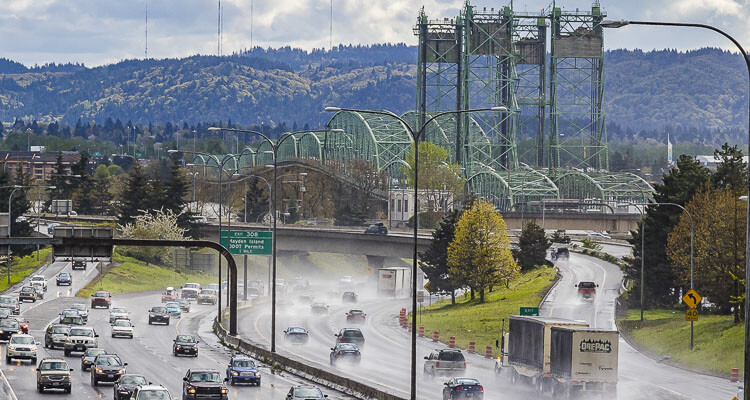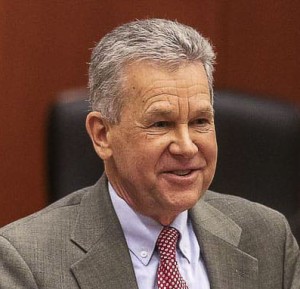
Resolution also opposes tolling on the I-5 and I-205 corridors in the Portland metropolitan area
Ken Vance, editor
Clark County Today
Members of the Clark County Council approved a resolution during its Wednesday Council Time in opposition to tolling the I-5 Bridge replacement and the I-5 and I-205 corridors in the Portland Metropolitan area. Councilors Karen Dill Bowerman, Gary Medvigy and Michelle Belkot voted in favor of the resolution and Councilors Glen Yung and Sue Marshall voted against it.
“I think our voices are important; I think the message is important,’’ Councilor Medvigy said during Wednesday’s discussion.

The issue was discussed during the Council Time meeting held on April 5. Following that discussion, a “white paper’’ was produced on April 11 detailing the County Council’s response to the Oregon Department of Transportation and Federal Highway Administration’s invitation for tolling feedback, the deadline of which is Friday (April 21). The “white paper’’ served as an outline and starting point for the County Council’s discussion regarding the updated resolution in opposition to the tolling proposal that will have an impact on Clark County residents, an estimated 75,000 of whom commute to Oregon for work.
The April 11 “white paper’’ is an update of the “white paper” adopted by the County Council on Nov. 1, 2022 in opposition to the Oregon Legislature proposing to toll I-205 and to initiate Mobility Pricing on the two corridors of the I-5 and the I-205. At that time, the councilors outlined seven locally-based points that should stand in order to justify tolling, citing that those points were not present. Those seven points were:
- Toll roads save time and money
- Tolls fund critical maintenance and improvement
- Tolling will be an economic growth engine
- Tolling is beneficial to the environment
- Double tolling on I-5
- Concerns with mobility pricing
- Cost of collection
The April 11 paper stated that “the tolling system places unreasonable burden on Washington residents, particularly low income residents, who cannot modify their work schedule and overall who can least afford the toll.’’ It also stated that the council will continue to follow in the footsteps of the Board of Councilors’ Resolution from 12-23-2015 when it adopted “a policy of opposing every Light Rail project in Clark County unless it is first supported by a majority of the voters in a countywide advisory vote of the people.”
The paper also pointed out that in 2013 there was an advisory measure on the ballot approved with 68.39 percent of the vote on whether the (then) Clark County Commissioners should oppose light rail if there was not a supportive countywide vote. The paper also stated that the Clark County Council “supports C-TRAN’s bus rapid transit as the best alternative for rapid transit on the I-5 Bridge because of its cost effectiveness compared to the MAX light rail option, its effectiveness in serving riders throughout the area and its agility in responding to transportation needs of the area.’’
Other concerns expressed in the paper include costs of the I-5 Bridge replacement project. “For example, given that the costs of the bridge have grown so astronomically, many contend that just federal and two-state monies along with limited local funds could not cover the total without inclusion of tolling. At the end of February, the program released new cost estimates of $5 billion to $7.5 billion. Most residents maintain that a $2.5 billion spread is a momentous spread that we are ill-prepared to deal with. From $1.6 billion to $2.45 billion is budgeted for actual replacement of the bridge itself, with the remaining funds budgeted on transit investments up to $2 billion, plus Oregon–Washington interchanges, roadways and another billion in both Oregon and Washington for work in each state.’’
In the paper, the council also notes “that such decisions are being made without a vote of the people, or even the 16 legislators of the Bi-State Bridge Committee. ODOT decided that light rail will be in the plan for the I-5 bridge replacement! Today’s extension of light rail from Portland to Vancouver travels on an elevated structure adjacent to I-5 in Vancouver, rather than track along city streets, also includes three new station locations. TriMet, however, has stated that they will not cover Vancouver’s O&M costs of MAX in Washington State; it is doubtful that those additional costs have been factored in. The State of Washington has given $1 billion and presumably Oregon will pledge $1 billion, knowing that ten years ago the Columbia River Crossing, then totaling “only” $3.4 billion, died because of the very inclusion of light rail. If both states come through with their commitment, and tolls are included in the total revenue, the program will also receive about $2.7 billion in federal funds which is now about 41% of the estimated total cost; most identify this level of federal funding as an essential component of the total and therefore include tolling to appease government demand.’’
In addition, the paper states that the “design of the bridge is still an unknown, and there are significant cost elements included in the unknown. Therefore, some claim that whereas state and federal money may be static, tolls can be variable, and therefore they must be included so that by project’s end, the funds needed can be brought to bear. One of the greatest design elements that is still unknown is the bridge’s height, which the U.S. Coast Guard says requires a minimum 178-foot clearance. A moveable span with either vertical lift or bascule method are the options that have greatest appeal because schedule would be least impacted according to the project director.’’
The proposed resolution that was approved Wednesday also stated that “the public narrative erroneously states that there is no opposition to I-5 tolling from Washington state,’’ citing the 2013 advisory vote where 68.39 percent opposed light rail.
During Wednesday’s discussion, Councilor Medvigy also asked for an introductory paragraph to be added to the April 11 “white paper’’ that stressed the need for additional travel corridors in the region.
“I think it is important for everyone to get the message that we need to plan for other corridors,’’ said Medvigy, who also believed that the light rail component should be separated from the I-5 Bridge replacement project. “It is an immensely complicated subject in itself.’’
Councilor Belkot expressed frustration that she has not been able to get ODOT officials to provide her answers to several questions. “ODOT continues to ignore the Coast Guard. ODOT wouldn’t answer any of my questions about what prices tolling would be. There are so many issues revolving around this. They are pretty much ignoring everyone who is involved.’’
Chair Bowerman questioned how the project’s cost estimates could even be taken seriously without a specific bridge design being provided.
Yung and Marshall said they agreed with elements of the April paper, but they had too many issues but they each wanted further discussion before they could support the resolution.
“I can’t support it as written,’’ Yung said. “The majority of it I agree with but it is way too rushed. I can’t put my name on this.’’
“There are too many moving parts to seize one position,’’ Marshall stated.
Comment deadline Friday (April 21)
By the end of 2025, ODOT expects to impose tolls along the entire lengths of both I-5 and I-205 from Wilsonville to the Washington state border. After that, the Interstate Bridge Replacement Program plans to charge tolls to cross the Columbia River on both I-5 and I-205.
Federal law allows anyone to comment on an Environmental Assessment. If the FHWA receives sufficient comments that demonstrate the negative impacts of ODOT’s tolling plan, then the agency may not approve the tolling plan.
If you wish to comment, send your comments to I205TollEA@odot.oregon.gov with “EA comments” in the subject line. The deadline for comments to be considered is this Friday, April 21, by 4 p.m.
Also read:
- Opinion: Hiding the growing cost of the Interstate Bridge replacementJoe Cortright of the City Observatory addresses the rising cost of the Interstate 5 Bridge replacement project.
- 90 minutes of delay on Southbound I-5 in Southwest Washington on Friday afternoon, July 26Travelers using southbound Interstate 5 through Woodland should expect up to 90 minutes of delay during Friday afternoon and evening and should delay travel or prepare for additional travel time.
- Nighttime paving work on I-5 and SR 14 in Clark County July 28-Aug. 9Nighttime travelers in Clark County should expect delays for maintenance and paving work beginning Sunday, July 28 until the morning of Friday, Aug. 9.
- Northeast 182nd Avenue/Northeast Ward Road to be closed on Aug. 1Northeast 182nd Avenue and Northeast 172nd Avenue in Clark County will have single-day closures on August 1 and August 5 for road preservation, with detours in place.
- Interstate Bridge Replacement program awarded $1.499 billion FHWA Bridge Investment Program grantInterstate Bridge Replacement program officials have shared that the program received $1.499 billion through the Federal Highway Administration’s Bridge Investment Program.









